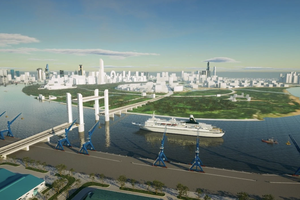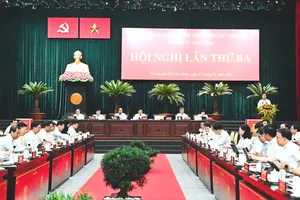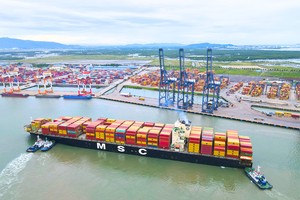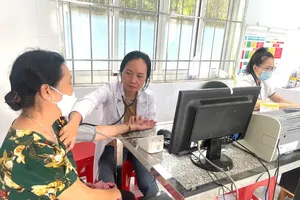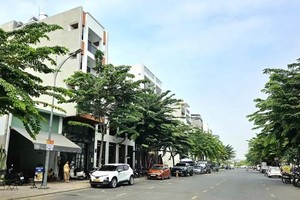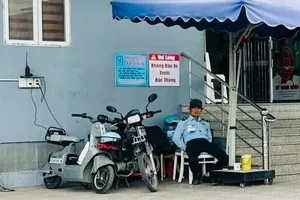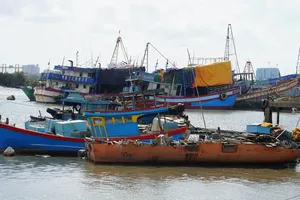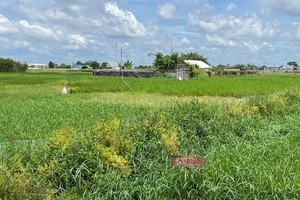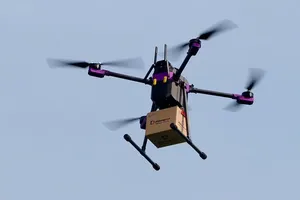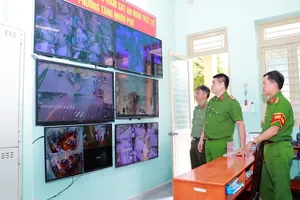 Border guard force gives support to households affected by Covid-19 pandemic. (Photo: SGGP)
Border guard force gives support to households affected by Covid-19 pandemic. (Photo: SGGP)
The no gunfire front
Colonel Pham Van Thang, Head of the HCMC Port Border Guard under the HCMC Border Guard, informed that his unit was entrusted to manage and control immigration on a large area, downstream of Saigon, Dong Nai, Nha Be, Long Tau, and Soai Rap rivers, with a total length of 150 kilometers. On the area managed by the unit, there are nine active ports, 103 wharves, and two waterway channels.
Every day, around 70-80 turns of vessels, along with hundreds of turns of watercraft, enter, exit, or anchor at the port border gate. Port border guards are responsible for preventing the Covid-19 pandemic from intruding the city by waterway. There is no gunfire on that battlefield but many difficulties. The Saigon River alone sees heavy traffic. For vessels to safely land, the port border guards must check and screen them carefully. Colonel Nguyen Tien Luy, Political Instructor of HCMC Port Border Guard, said that the unit applied information technology in the control and management of immigration. Despite strictly implementing pandemic prevention measures, avoiding direct contact, border guards still must ensure the principle of seeing with their own eyes.
To ensure Covid-19 prevention, the unit built multi-layer checking, covering each other. Vessels must moor at the waters of Vung Tau City and could enter the estuary after being tested for Covid-19. Those with crew members given positive results for Covid-19 were isolated timely, not letting the disease spread to the community. The border guard force also cooperated closely with the People’s Committee of Nha Be District in exchanging information and reporting the number of anchored vessels. Crew members infected with Covid-19 were treated in Go Gia and Thieng Lieng isles.
Firm on the outside, tight on the inside
Colonel Pham Van Thang said that the front to prevent the intrusion of the Covid-19 pandemic from the sea was firmly built. The prevention program against the Delta variant of the border guards was initially successful. On December 19, 2021, the unit received information from the Ministry of Health that the Omicron variant entered Vietnam via air. Border guards at the port border gate in HCMC have actively built a prevention plan, stayed confident, and reminded each other to continue to raise their caution and enter the battle of preventing the new variant of Omicron from entering by sea.
Specifically, the Commanding Board of HCMC Port Border Guard has proactively planned and organized forces from the Commanding Board to the border guard stations and teams at the port border gates, such as Khanh Hoi, Tan Thuan, Ben Nghe, Phu My, Hiep Phuoc, and Nha Rong, to enter the battle with a firm spirit, not letting the pandemic enter and spread to the community.
Lieutenant Colonel Hoang Van Trung, Head of Border Guard Station at Nha Rong Port, added that to prevent the pandemic from going ashore, the unit had built a solid battle position. Since entering the campaign, 100 percent of the troops must stay at the barrack and are not allowed to go home. Along with the organization of closed patrols is the tight control of vehicles, officers, employees, and crew. The unit has organized mobilization and supported people in the area where it is stationed. To ensure the health of border guards, besides raising awareness, the unit has proactively contacted the competent authorities to organize screening tests for officers and soldiers. Results are always 100 percent negative.
Units on the whole line must always thoroughly grasp all developments in the area, goals, and subjects. Twenty-four checkpoints are strictly maintained 24/24 hours a day, focusing on controlling sailors, foreign crew members, and workers getting on and off the ship. “The unit has cooperated with specialized port management agencies and the HCMC Center for Disease Control to agree on the process of controlling vessels entering Vietnam from the pandemic-hit areas. Up to this point, no crew members who tested positive for Covid-19 spread the disease to the community," said Colonel Pham Van Thang.
Colonel Pham Van Thang, Head of the HCMC Port Border Guard under the HCMC Border Guard, informed that his unit was entrusted to manage and control immigration on a large area, downstream of Saigon, Dong Nai, Nha Be, Long Tau, and Soai Rap rivers, with a total length of 150 kilometers. On the area managed by the unit, there are nine active ports, 103 wharves, and two waterway channels.
Every day, around 70-80 turns of vessels, along with hundreds of turns of watercraft, enter, exit, or anchor at the port border gate. Port border guards are responsible for preventing the Covid-19 pandemic from intruding the city by waterway. There is no gunfire on that battlefield but many difficulties. The Saigon River alone sees heavy traffic. For vessels to safely land, the port border guards must check and screen them carefully. Colonel Nguyen Tien Luy, Political Instructor of HCMC Port Border Guard, said that the unit applied information technology in the control and management of immigration. Despite strictly implementing pandemic prevention measures, avoiding direct contact, border guards still must ensure the principle of seeing with their own eyes.
To ensure Covid-19 prevention, the unit built multi-layer checking, covering each other. Vessels must moor at the waters of Vung Tau City and could enter the estuary after being tested for Covid-19. Those with crew members given positive results for Covid-19 were isolated timely, not letting the disease spread to the community. The border guard force also cooperated closely with the People’s Committee of Nha Be District in exchanging information and reporting the number of anchored vessels. Crew members infected with Covid-19 were treated in Go Gia and Thieng Lieng isles.
Firm on the outside, tight on the inside
Colonel Pham Van Thang said that the front to prevent the intrusion of the Covid-19 pandemic from the sea was firmly built. The prevention program against the Delta variant of the border guards was initially successful. On December 19, 2021, the unit received information from the Ministry of Health that the Omicron variant entered Vietnam via air. Border guards at the port border gate in HCMC have actively built a prevention plan, stayed confident, and reminded each other to continue to raise their caution and enter the battle of preventing the new variant of Omicron from entering by sea.
Specifically, the Commanding Board of HCMC Port Border Guard has proactively planned and organized forces from the Commanding Board to the border guard stations and teams at the port border gates, such as Khanh Hoi, Tan Thuan, Ben Nghe, Phu My, Hiep Phuoc, and Nha Rong, to enter the battle with a firm spirit, not letting the pandemic enter and spread to the community.
Lieutenant Colonel Hoang Van Trung, Head of Border Guard Station at Nha Rong Port, added that to prevent the pandemic from going ashore, the unit had built a solid battle position. Since entering the campaign, 100 percent of the troops must stay at the barrack and are not allowed to go home. Along with the organization of closed patrols is the tight control of vehicles, officers, employees, and crew. The unit has organized mobilization and supported people in the area where it is stationed. To ensure the health of border guards, besides raising awareness, the unit has proactively contacted the competent authorities to organize screening tests for officers and soldiers. Results are always 100 percent negative.
Units on the whole line must always thoroughly grasp all developments in the area, goals, and subjects. Twenty-four checkpoints are strictly maintained 24/24 hours a day, focusing on controlling sailors, foreign crew members, and workers getting on and off the ship. “The unit has cooperated with specialized port management agencies and the HCMC Center for Disease Control to agree on the process of controlling vessels entering Vietnam from the pandemic-hit areas. Up to this point, no crew members who tested positive for Covid-19 spread the disease to the community," said Colonel Pham Van Thang.
From the end of 2020 to November 30, 2021, the HCMC Port Border Guard had completed entry procedures for nearly 7,500 vessels, with more than 127,290 crew members. The unit had detected 245 crew members of 73 vessels infected with Covid-19, including 115 foreigners.
Colonel Nguyen Tien Luy said that when facing an invisible enemy, soldiers on the front lines could not avoid losses. Recently, the whole unit had 24 officers and soldiers infected with Covid-19.
Colonel Nguyen Tien Luy said that when facing an invisible enemy, soldiers on the front lines could not avoid losses. Recently, the whole unit had 24 officers and soldiers infected with Covid-19.
